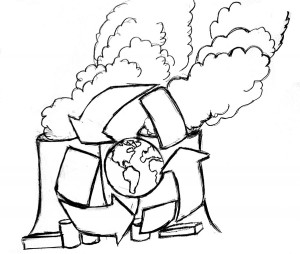Stigma against nuclear energy needs to change
Greenhouse gases took center stage at the U.N. summit on climate change in late September, with more than 100 global leaders discussing the pledge to reduce emissions. President Barack Obama promised that America’s carbon emissions will be at least 17 percent below 2005 levels by the year 2020. Considering that energy production accounts for more of our country’s carbon emissions than any other contributor, it is clear that it is time to rely on a new primary source of energy. What many don’t realize, however, is that this alternative already exists in nuclear power.
Nuclear power production has rapidly grown since the 1930s, but drew negative connotations after the well-known Chernobyl, Three Mile Island and, more recently, Fukushima accidents. Since 1996, global nuclear power production has dropped by 7 percent, as the general public and investors alike have increasingly favored solar and wind power.
After decades of slow nuclear power growth, a new reactor is set to open at the Watts Bar Nuclear Generating Station in Tennessee within the next year. While several plants were decommissioned in the past few years, the Tennessee plant will be the first new commercial one finished in the United States since the turn of the century. Hopefully, this plant will spur a nuclear power revival in the United States.
This potential revival could be stalled by the negative stigma surrounding nuclear power. Concerns about safety, environmental impact and waste management cause many opponents to reject nuclear power as a viable energy option. Nevertheless, it’s time for opponents to realize that compared to other energy sources, including wind, solar and coal, nuclear energy is the best possible option. As with anything else, nuclear power might have its downsides, but the pros outweigh the cons.
One obvious reason that nuclear power is our best option for a new primary energy source is carbon emissions. Carbon emissions are one of the main contributors to the greenhouse effect, which in turn influences climate change. Coal energy production emits over 2,000 pounds of carbon dioxide per megawatt hour of energy produced. Comparatively, nuclear power plants emit practically zero carbon dioxide while producing energy.
Today, the United States is one of the world’s top carbon dioxide emitters. Though the country can’t completely switch from coal power plants to nuclear power overnight, a gradual shift could set an example for other countries. If the United States went from being known as the country with the highest rates of carbon dioxide emissions per capita to the country with the lowest level of carbon dioxide emissions, other countries might reevaluate their own practices.
Proponents of other energy sources such as wind and solar argue that these energy sources also emit less carbon than coal. Wind farms and solar photovoltaic parks, however, occupy much more space than nuclear power plants. They can require anywhere between 50,000 and 180,000 acres, compared to an average of approximately 400 acres for a nuclear power plant.
In addition to using more space, solar and wind sources actually produce less energy than nuclear for each dollar spent on energy production. If one of these options became the United States’ primary energy source, we would be sacrificing vast amounts of space for a relatively small amount of energy.
Though nuclear energy sounds like the best option for the Earth, many worry about whether it is the best option for us. Past nuclear accidents have left people wary of possible disasters. But the Chernobyl accident, which opponents frequently cite as an example of the danger of nuclear power, occurred at a plant without concrete containment structures, a necessary safeguard to ensure that deadly radiation doesn’t escape into the atmosphere. Power plants in the United States include these containment structures, eliminating the threat of an accident similar to Chernobyl. Developers have learned from prior accidents, improving overall safety. The new Tennessee plant will be equipped with features such as back-up cooling systems and emergency equipment. Any other new U.S. plants would likely contain similar safety features.
Another major concern held by nuclear power’s opponents is the question of waste management. Nuclear reactors produce radioactive waste that is not biodegradable. Currently, this waste is frequently stored in on-site cooling vats, which experts consider an acceptable practice for now. The actual amount of waste produced by nuclear plants is relatively small, as “all the waste produced so far in the U.S. would only cover a football field about 5 yards deep,” according to the Wall Street Journal.
Thinking long-term, storing nuclear waste in these cooling vats essentially buys time for researchers to develop new solutions. Once public support for nuclear power increases, construction of new plants will bring about new developments. Increased investment can bring about improvements that alleviate the remaining problems with nuclear power.
The shift away from coal power plants can’t be completed quickly, so it’s imperative that we begin this change as soon as possible. Instead of waiting for a brand new miracle solution, it’s time to focus efforts on improving our best current option. It’s time to remove the stigma attached to nuclear power.



Relative safety…
Here is one way to compare the safety of our largest energy sources: Deaths Per Terra Watt Hour Produced. Nuclear power is the safest – by far.
Cheers.
Nuclear power production didn’t exist in the 1930s.